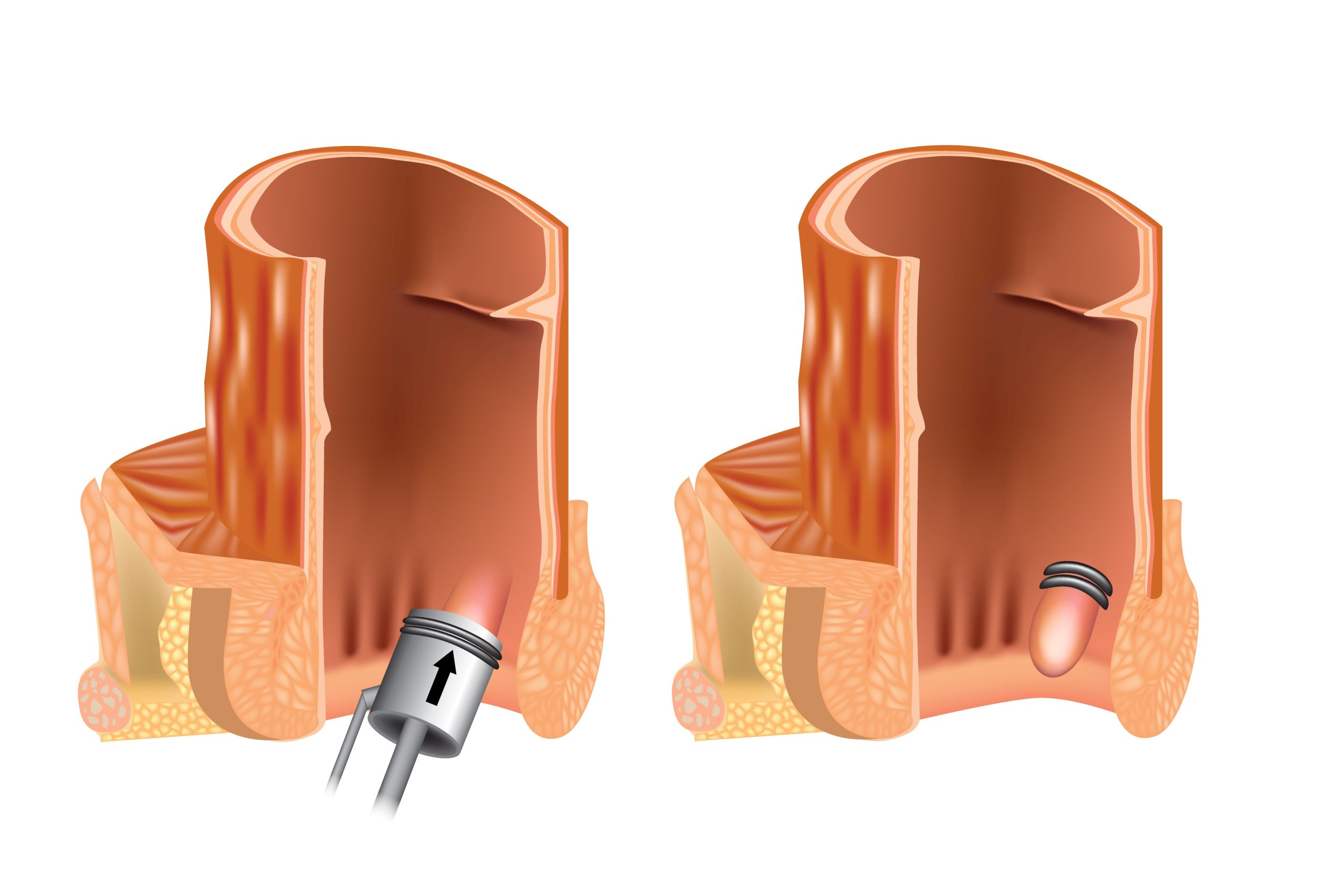Conditions And Treatments
Home / Areas Of Specialty / Rubber Band Ligation Of Hemorrhoid
Rubber Band Ligation Of Hemorrhoid
Rubber Band ligation of hemorrhoid is a quick office procedure meant to treat only internal hemorrhoids. There are two main types of hemorrhoids -Internal and external. Rubber banding is a very quick office procedure where your surgeon will insert anoscope inside the anus and visualize the internal hemorrhoid. Your surgeon will then place a band on the internal hemorrhoid with the help of special device. However, you may have minimal discomfort, but it rarely causes severe pain. Eventually, rubber band will cut off the hemorrhoid’s blood supply. This will cause the hemorrhoid to shrink and fall off. It usually falls off in 1-3 days but sometimes may take longer.
Can you perform this procedure in office without anesthesia?
Colorectal surgeons can perform rubber band ligation procedure in the office. This does not require any sedation anesthesia and patients can go about their daily activities right after the procedure. Very rarely you may have severe pain, bleeding, infection or fever or other symptoms. Additionally, your surgeon may repeat the rubber banding procedure two to three times to shrink the hemorrhoids and for maximum effectiveness.
How to Prepare for the Rubber Banding procedure
You do not need any special preparation before the rubber band ligation procedure. Your Colorectal surgeon will give you all the instructions before the procedure. Blood thinner medications are like aspirin, plavix, coumadin, brillanta, elequis and similar medications. However, these medications increase the risk of bleeding. So, your surgeon will instruct you to stop these medications before the procedure. Please discuss this in detail with your Colorectal surgeon and your primary care physician or your cardiologist. Another key point is that Rubber band ligation is an office procedure, and you will not get any sedation or anesthesia. Rubber Band ligation causes minimal discomfort, and most patients go back and return to their activities. Rarely this can cause severe pain, bleeding, infection, urine retention and sepsis.
Are there any post procedure instructions after Hemorrhoid Rubber banding?
Your Surgeon will give you details instructions in regard to side effects and the risks like any other procedure. Please read the instructions before the procedure and ask any questions.
Few important post hemorrhoid banding procedure instructions are:
- You may have some pain, bleeding, or itching after the rubber band ligation procedure. This is normal and should go away in a few days.
- Patients may get dizzy or lightheaded sometimes immediately after the procedure, so we do not recommend driving or doing any heavy work at least for 15-20 minutes after the procedure.
- You can take over the counter pain meds as tylenol, ibuprofen to ease the discomfort. If those do not work then you can call your surgeon office to have a different prescription.
- You can apply ice packs or cold compresses to the anal area if needed to reduce swelling and for comfort.
- You can soak your anal area in warm water (sitz bath) for 10-15 minutes, 2-3 times a day to relieve pain and itching if needed.
- You should avoid straining during bowel movements, as this can cause bleeding or infection. You can use stool softeners or laxatives if you have constipation.
- You should eat a high-fiber diet and drink plenty of fluids to prevent constipation.
- You should avoid heavy lifting, strenuous exercise for a day or two after rubber band ligation procedure until you feel back to normal.
- You should contact your doctor if you have severe pain, fever, chills, excessive bleeding, difficulty urination or signs of infection.
What are Hemorrhoids, can you please explain?
Hemorrhoids are a part of normal anatomy of human body. They are present in the anus which is the last part of human large intestine. Hemorrhoids are also known as Piles. They consist of blood vessels and connective tissue and work as cushions during bowel movements. Enlarged hemorrhoids can cause stretching of blood vessels and lead to bleeding.
Types of Hemorrhoids
External hemorrhoids are outside the anus on the skin. You should not have any bleeding or pain unless they have thromboses/blood clots. That condition is called thrombosed external hemorrhoids and they can appear as a lump in the anal area. This can cause significant pain, discomfort and occasional bleeding. Your colorectal surgeon should be able to treat this condition with a small procedure in the office. It usually leads to faster recovery.
Internal hemorrhoids are inside the anal canal and can lead to significant Bleeding, protrusion, thrombosis, pain.
Does Rubber Band ligation of hemorrhoid work for the External hemorrhoids?
Colorectal surgeons perform rubber banding procedure only for Internal hemorrhoid management. External hemorrhoids which are on the outside skin which is sensitive area and banding does not work. Excisional hemorrhoidectomy surgery is the procedure meant for External Hemorrhoids. In excisional hemorrhoidectomy your colorectal surgeon can remove both internal and external hemorrhoids at the same time. But this procedure requires anesthesia and can have a painful recovery.
What should I change in my diet and lifestyle to prevent and treat hemorrhoids?
Hemorrhoids are swollen veins in your anus and lower rectum that can cause pain, itching, bleeding and discomfort. They can be caused by various factors, such as straining during bowel movements, sitting for long periods of time on the toilet, having chronic diarrhea or constipation, higherweight, being pregnant, having anal intercourse, eating a low-fiber diet or lifting heavy objects.
To prevent or treat hemorrhoids, it is recommended that you eat more foods that are high in fiber, such as fruits, vegetables, grains, beans, nuts and seeds. Fiber can help soften your stools and make them easier to pass, reducing the pressure on your hemorrhoids. Fiber can also help reduce inflammation and bleeding.
Some examples of fiber-rich foods are:
- High-fiber bran cereal
- Shredded wheat cereal
- Pears
- Apples
- Raspberries
- Prunes
- Green peas
- Collard greens
- Sweet potatoes
- Potatoes with skin
- Winter squash
- Navy beans
- Pinto beans
- Kidney beans
You should also drink plenty of water and other liquids to keep yourself hydrated and have a good bowel movement.
On the contrary, you should limit food low in fiber like cheese, dairy foods, any kind of meat, alcohol, caffeine and refined food. Finally, eating a healthy diet for hemorrhoids can help you relieve your symptoms and improve your quality of life.
What is a colon and Rectal Surgeon? Is Dr Singh a Board-certified Colorectal surgeon? and where does he perform his procedures.
Colon and rectal surgeons are experts in the surgical and non-surgical treatment of diseases of the colon, rectum, and anus. They have completed advanced surgical training in the treatment of these diseases, as well as full general surgical training. They are well versed in the treatment of both benign and malignant diseases of the colon, rectum, and anus and are able to perform routine screening examinations and surgically treat conditions as and if needed. Dr Singh is a double board certified in Colon and Rectal Surgery and General surgery. His practice is located in Phoenix, Glendale and Scottsdale, AZ. Dr Singh routinely performs rubber band procedure in the office.
For more information on hemorrhoids please visit:
Hemorrhoids | ASCRS (fascrs.org)
Home – Colon & Rectal Care Center of Phoenix (colorectaldoc.com)



